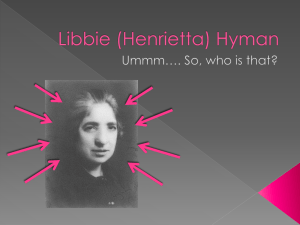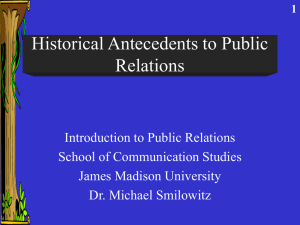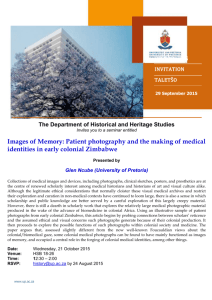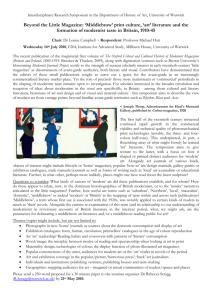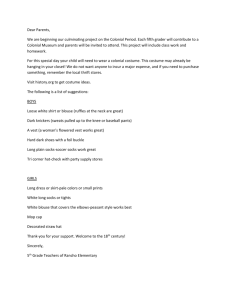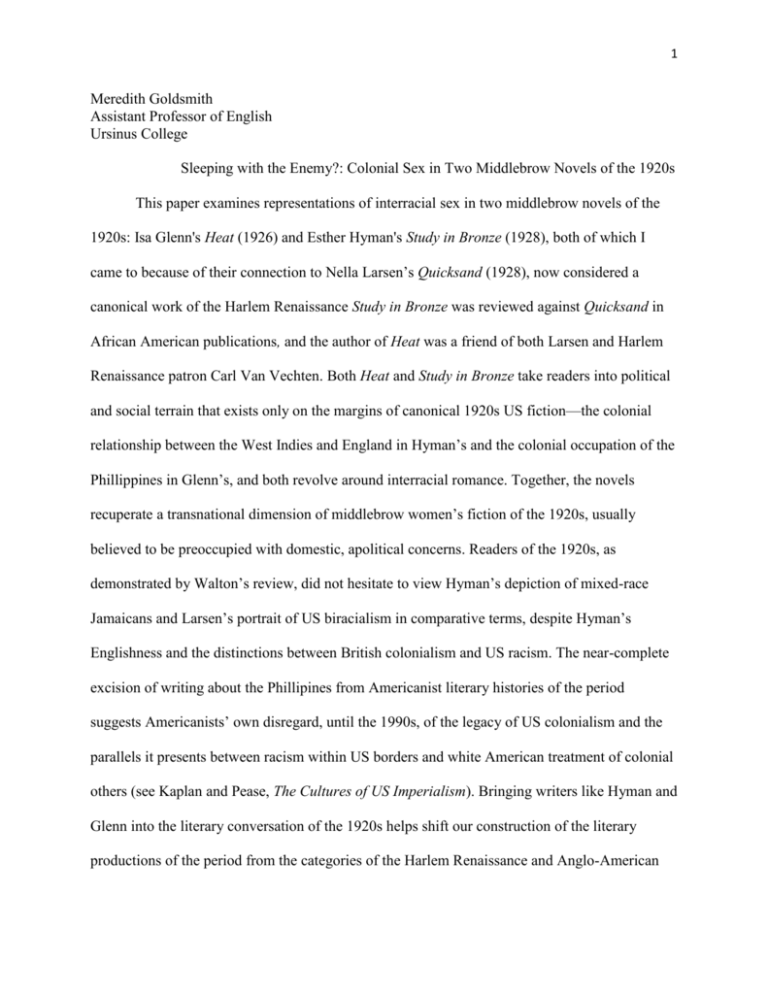
1
Meredith Goldsmith
Assistant Professor of English
Ursinus College
Sleeping with the Enemy?: Colonial Sex in Two Middlebrow Novels of the 1920s
This paper examines representations of interracial sex in two middlebrow novels of the
1920s: Isa Glenn's Heat (1926) and Esther Hyman's Study in Bronze (1928), both of which I
came to because of their connection to Nella Larsen’s Quicksand (1928), now considered a
canonical work of the Harlem Renaissance Study in Bronze was reviewed against Quicksand in
African American publications, and the author of Heat was a friend of both Larsen and Harlem
Renaissance patron Carl Van Vechten. Both Heat and Study in Bronze take readers into political
and social terrain that exists only on the margins of canonical 1920s US fiction—the colonial
relationship between the West Indies and England in Hyman’s and the colonial occupation of the
Phillippines in Glenn’s, and both revolve around interracial romance. Together, the novels
recuperate a transnational dimension of middlebrow women’s fiction of the 1920s, usually
believed to be preoccupied with domestic, apolitical concerns. Readers of the 1920s, as
demonstrated by Walton’s review, did not hesitate to view Hyman’s depiction of mixed-race
Jamaicans and Larsen’s portrait of US biracialism in comparative terms, despite Hyman’s
Englishness and the distinctions between British colonialism and US racism. The near-complete
excision of writing about the Phillipines from Americanist literary histories of the period
suggests Americanists’ own disregard, until the 1990s, of the legacy of US colonialism and the
parallels it presents between racism within US borders and white American treatment of colonial
others (see Kaplan and Pease, The Cultures of US Imperialism). Bringing writers like Hyman and
Glenn into the literary conversation of the 1920s helps shift our construction of the literary
productions of the period from the categories of the Harlem Renaissance and Anglo-American
2
modernism toward “middlebrow race fiction”—works by writers from a number of racial and
ethnic backgrounds grappling with a series of related issues—biracialism, the assimilation of
ethnic minorities, and the opportunities for and limitations on the black middle-class, among
others.
I begin with a discussion of Hyman’s Study in Bronze. A white colonial, Hyman was the
editor of the Saturday Review of Jamaica, a journalist and author of several other novels. Study
in Bronze tells the story of the biracial Lucea Richmond, the product of an illicit union between a
Jamaican woman and a white Englishman. Mr. Richmond teaches Lucea to idealize whiteness
and leads her to believe that England will offer her an ideal life, free of colorism and the taint of
her illegitimacy. With dreams of artistic self-realization, she travels to London after her father’s
death, begins to write poetry seriously, and explores the opportunities available to her as a single
woman, which the represents through a series of New Women artists, high-class prostitutes, and
sexual renegades. After a disappointing affair, she returns to Jamaica, determined to move
forward with her poetry, but disillusioned in her belief that England—and the interracial
marriage for which she has hoped—will resolve her dilemmas of identity as a middle-class,
brown-skinned, Jamaican female artist.
From the very beginning, Hyman’s work exemplifies the white ambivalence toward
miscegenation characteristic of white middlebrow race fiction (also seen in the work of Carl Van
Vechten, Vera Caspary, and Fannie Hurst). Study in Bronze announces an ambivalent
relationship with Harlem Renaissance literary production through its epigraph, which cites
Langston Hughes’s “Mulatto” (Fine Clothes to the Jew [1927]) in its entirety. The poem tells the
story of a “little yellow bastard boy” who cries out to the white father for recognition, and
Hyman’s inclusion of it suggests that a sympathetic portrayal of the dilemma of biracialism will
3
follow. However, the first part of the novel contradicts the message of Hughes’ poem. As the
first chapter vacillates between Lucea’s and her father’s point of view, we learn that Lucea has
already internalized the lesson that “white men were better than black men—she didn’t care what
people said” (13). Mr. Richmond’s first goal is to teach Lucea standard English and emotional
repression, wishing to turn her into a “little Spartan so that, whatever came [i.e., whatever
happened to her as a woman] there was one thing she could never lose, her dignity” (22).
Richmond’s efforts at racial and sexual control of Lucea reflect his disgust at his own sexual
desires, which allowed the “dregs, perhaps, of two races” to join “in the half-hearted passion
induced by rum and deliberate contact” (9). Here, “passion” does not lead to “deliberate
contact,” but “deliberate contact” produces “passion,” casting sexual desire as a product of the
erosion of social boundaries. Thus, Richmond’s goal for to have her “grow to womanhood, . . .
marry some brown chap, or—reversion to type—a black. . . ” (21), keeps her boundary-crossing
potential in check.
Hyman goes one step further than what we might expect of the narrative of the tragic
mulatta from earlier twentieth-century American fiction by casting Lucea’s desires, as forged
through her relationship with her father, in masochistic terms. When Richmond removes his
child from her family’s yard, he holds her hand “so hard that it hurt, with a sharp, pleasant pain
where [her] fingers were pressed too close together” (14). Mr. Richmond alternates between
rewarding Lucea with affection and punishing her with isolation, and the novel is not subtle
about his daughter’s Oedipal feelings: “She could almost infallibly get an ecstatic thrill. . . by
pondering her love for her father. That was a delicious tingle of feeling that started at her
fingertips, and travelled, by way of her heart, down to her toes” (39). Her adoration of her white
father is complemented by her aversion to Jamaican maternal figures, a series of brown and
4
light-skinned governesses that her father has placed in her life. Despite her father’s efforts to
orient her toward men of color for marriage, Lucea learns to associate white men--especially
older white men--with painful, yet beneficial instruction. Eventually, her expectation that
pleasurable attention from white men will be mingled with pain becomes a more explicit wish:
after a tortuous experience at the dentist, in which “it was if he loved her and gave her pain,”
sadistic imagery leaps to Lucea’s mind (247), and she commits this experience to a poem that
she is unable to destroy (247). I quote this episode because it provides one example of how the
“middlebrow” race fiction of the period differs from its more modernist and canonically valued
counterparts. While the fiction of Nella Larsen and Jessie Fauset’s features masochistic heroines,
their self-wounding impulses rarely reach the erotic realm. These genteel African American
writers needed to protect their heroines from charges of libertinism. In Hyman’s suggestion that
“sadism” is part of Lucea’s vocabulary, she evokes a familiarity with psychoanalytic and sexual
discourses of the era that Larsen and Fauset’s heroines might well know, but from which they
would wish to distance themselves.
.
If Lucea’s masochistic behavior links her to Larsen and Fauset’s heroines, Hyman also
charts a trajectory for her heroine that modernists like Larsen did not deem fully possible, a
realization of her artistic sensibilities. Lucea has yearned to be a poet from early childhood,
enjoys modest success publishing with magazines in Jamaica and England, and by the end of her
time in England is developing a collection of poetry. This is the only novel of the black heroine
of the 1920s that I have read that positions the heroine as a successful writer, as opposed to a
painters, performe, fashion designer, or model. Although Hyman provides her heroine an option
that its more celebrated companion texts do not, Lucea’s artistic education also serves her
father’s repressive aims: in fact, Richmond responds to her first published poem, a sentimental
5
effort in praise of her garden, by shaming her over her tendency to “bathos” (62). A series of
white male readers dismiss the feminine, Jamaican, and middlebrow elements of Lucea’s work
as “voluptuous,” “overcrowded,” “self-conscious,” and moody. By the final chapter, which
depicts her return to Jamaica after years of absence, she begins to write a sonnet, showing her
identification with modernist notions of formal control: in this form, the narrator reminds us,
“there was no room for slovenliness of any kind” (316). With her newly aesthetically sensitive
gaze at the Jamaican people and landscape on her return, Lucea emerges as an ideal colonial
artist for a white readership: one who can see the colonies from a British perspective and
represent them in a traditional literary form.
The interracial relationships in Study in Bronze suggest Hyman’s opinions on the
possibilities of both interracial unions and the colonial-metropolitan dyad. Lucea’s relationships
with white men, beginning with her father, offer a form of benevolent paternalism in which
colonials assimilate to English standards. The text offers no possibility of an interracial union
between equals and no place for the mulatta artist in England; after Lucea is rejected by her
white lover, Ronald Petty, who drunkenly admits that she is “too damned exotic” (272) to marry,
the novel holds out the brown-skinned Keith Firbank, a Jamaican doctor Lucea meets on her first
crossing to England, as a possible partner upon her return. In the potential union with a brownskinned middle-class Jamaican partner, Hyman firmly draws the line at the production of more
of what Hughes calls “little yellow/Bastard boys.”
I turn now to Isa Glenn’s Heat, which, like Study in Bronze, announces its affiliation with
Harlem Renaissance literary production—in this case through the novel’s dedication to Carl Van
Vechten, whose Nigger Heaven was also published in 1926; Glenn’s fiction was also actively
reviewed in Harlem Renaissance publications. Countering the popular perception of the
6
American occupation of the Phillippines as a period of benevolent assimilation, Heat argues that
the US relation to the Phillippines revolves around miscegenous desire and anxieties. The novel
portrays the efforts of three white protagonists—officer Tom Vernay, teacher Charlotte Carson,
and engineer Richard Saulsbury—to establish themselves in colonial Manila in the years leading
up to World War I. Each character succumbs to miscegenation anxiety during their period in the
tropics: Vernay maintains a sexualized view of the city of Manila itself, viewing its Spanish
quarters as an exotic, feminized space; Saulsbury openly hankers after the “fine little pieces of
human flesh” (14) the new environment makes available; and Charlotte worries that the islands
will destroy her whiteness through promiscuous social—if not sexual—contact. The novel
destabilizes the previously unsullied racial and sexual invulnerability of its protagonists, as the
men succumb to affairs with Spanish and indigenous women (despite the army’s importation of
American prostitutes) and military wives become “gimme girls” who solicit male support for
extra income. Glenn engages in a simultaneous critique of US colonial attitudes and white
Americans’ belief in their racial autonomy, as the novel reveals how whiteness and colonial
power depend upon the appearance of authority.
Heat articulates a series of contradictory positions among its white Americans about
“going native” in the Phillippines. From the beginning, Vernay observes the American
community’s refusal to assimilate to the norms of tropical culture, and his own desire to adapt to
the new environment corresponds to his classical view of the colonial other as exotic feminine.
Vernay initially registers his sense of this otherness—based primarily on a romantic vision of
Spanish culture—through his depiction of the Walled City, Manila’s Spanish quarter (23). He
observes that the “gardens were locked against Americans….the secret flowers which smelt of
the honey of Paradise. . .the Dama de la Noche [ladies of the evening]—were always in hidden
7
gardens, and always sending for their little, dainty, insinuating whispers of delights” (23). The
Spanish gardens function as a metaphor for both the cloistered quality of the colony itself and the
lure of Spanish women, Vernay’s ultimate downfall. Vernay enacts his passion for the “hidden
flowers” of colonial culture through a fatal romance with Dolores, the daughter of a Spanish
aristocrat, who, just like Manila, had been “hidden behind a mantilla” (130). However, just as
whiteness is revealed to depend on appearance, we learn that Dolores has been attracted to the
brass buttons on Vernay’s uniform rather than his blue eyes; when he resigns his commission to
marry her, she leaves the country and marries a German soldier from Tsingtao, forcing him to
realize that his fascination with difference has been matched by hers.
Glenn makes Vernay’s decline predictable from early in the novel, as he falls into an
affair with the indigenous woman Josefa (previously the mistress of Saulsbury, who has become
an unapologetic “squaw man” [252]). The novel’s closure returns to the anxieties about “going
native” with which the novel began: Charlotte and Saulsbury find Tom with Josefa, who flaunts
her pregnant body to Charlotte, all the while holding a “shining pale yellow” (312) infant on her
hip. Tom’s degradation is signaled in his mixture of Filipino clothing, including underwear made
of the indigenous fabric sinamay, with the remains of his US uniform. In the final scene, Josefa
is “fondling Vernay,” for the two Americans’ horrified gaze, “slowly drawing her hands down
his bare chest, possessively; … while he stood rigid, suffering her caresses and occasionally
quivering” (317). Vernay has believed in his own ability to penetrate the mysteries of a
cloistered, feminized Spanish Manila in the figure of Dolores; by the novel’s end, he becomes a
sexual object, powerless in the face of native seduction.
It would be possible, based on this last scene, to view Heat as an anticolonial argument
against miscegenation, where the negative results of colonialism are the “little yellow/Bastard
8
boys,” in Hughes’s words, produced by interracial unions. However, Glenn shows that it is men
and women with romantic ideals—whether Vernay’s exoticism or Charlotte’s belief in uplift-who are damaged by “going native”: Saulsbury, in contrast, who leaves the islands relatively
unscarred, views both the erotic and commercial possibilities of the Phillippines in completely
pragmatic terms. Charlotte, whose deterioration manifests in racist abuse of her students, a
growing theft habit, and haggling (a consumer behavior she formerly decried), ends by admitting
that “this part of the world…just dried me up” (308). Heat shows that the US relationship with
its colonial territories revolves around issues of sex as well as race, showing how the stability of
white gender identities falters when placed in contact with the US’s colonial and racial others.
It is my belief that texts like Study in Bronze and Heat offer a significant addition to the
study of race in 1920s US American fiction. First of all, they highlight the role of white female
authors in the discourse around race in the period, showing the interpenetration of issues of race
with the typical subject matter of women’s fiction of the era: romance and marriage; creative
self-realization; and professional opportunities for women, like the middlebrow and popular texts
that Patricia Raub discusses in Yesterday’s Stories: Popular Women’s Novels of the Twenties and
Thirties. They also point out that the early twentieth-century obsession with miscegenation
spread beyond the boundaries of the US and past the categories of black and white. Finally,
these two novels grapple with the effects of racial ideologies on sexual behavior much more
graphically than their more celebrated counterparts, which tend to take on such issues in a more
covert way (see, for example, Larsen’s Passing). The Freudian notion of repression—not only
repressed sexuality but repressed or hidden meaning--as a sign of literary value is intimately tied,
I believe, to the rise of New Criticism as a discipline (see Radway, 228), which encouraged
readers to privilege the repressed implications of the text rather than their surface concerns, and
9
thus privileged the indecipherability of modernist texts over the explicitness of their less
sophisticated counterparts. Texts like Study in Bronze and Heat leave little to the imagination; it
is not for nothing that both of the novels I’ve talked about today engage in detailed consideration
of their protagonists’ underwear. While the occasional lack of subtlety of such works has
contributed to their critical dismissal, Hyman and Glenn raise issues of sex, race, and colonialism
in ways that makes both novels worthy of new consideration, expanding our understanding of
race fiction in the 1920s.
Works Consulted
Glenn, Isa. Heat. NY: Knopf, 1926.
Hutner, Gordon. What America Read: Taste, Class, and the Novel, 1920-1960. Chapel Hill, NC:
UNC Press, 2009.
Hyman, Esther. Study in Bronze. NY: Henry Holt, 1928.
Kaplan, Amy and Donald Pease, eds. Cultures of United States Imperialism. Durham, NC: Duke
UP, 1993.
Radway, Janice. “Research Universities, Periodical Publication, and the Circulation of
Professional Expertise: On the Significance of Middlebrow Authority.” Critical Inquiry
31 (2004): 203-228.
Raub, Patricia. Yesterday’s Stories: Popular Women’s Novels of the Twenties and Thirties.
Westport, CT: Greenwood Press, 1994.




